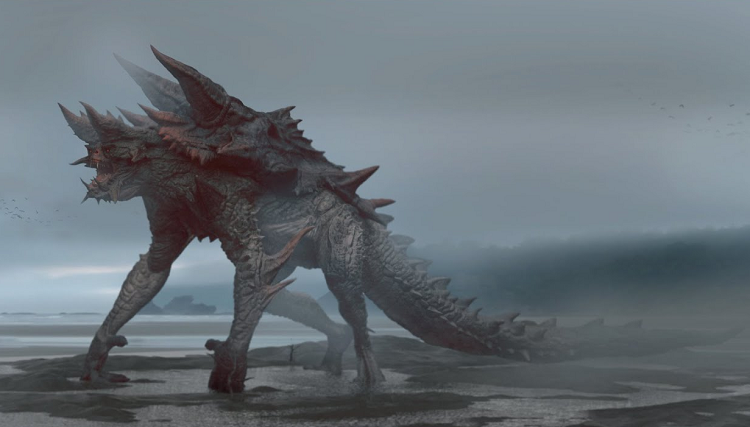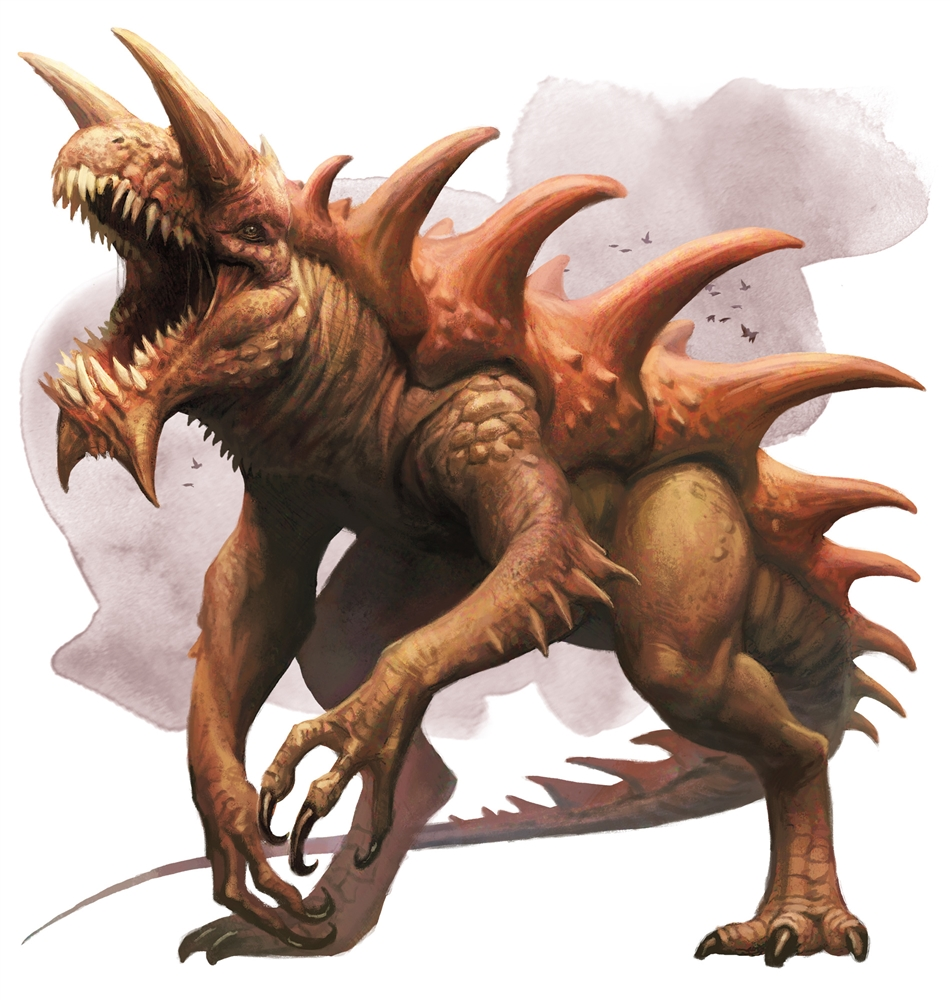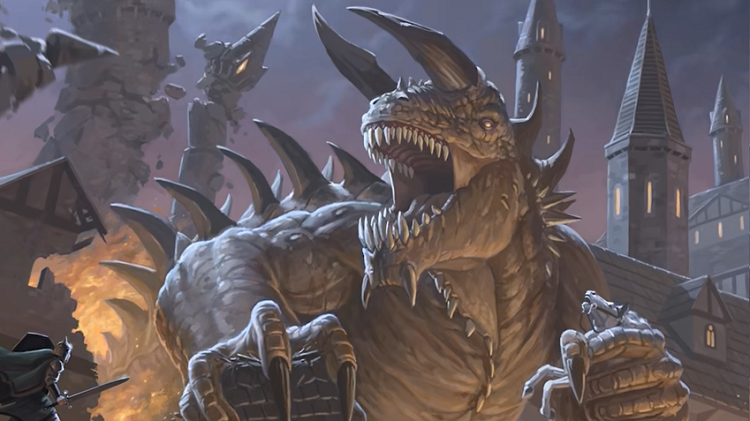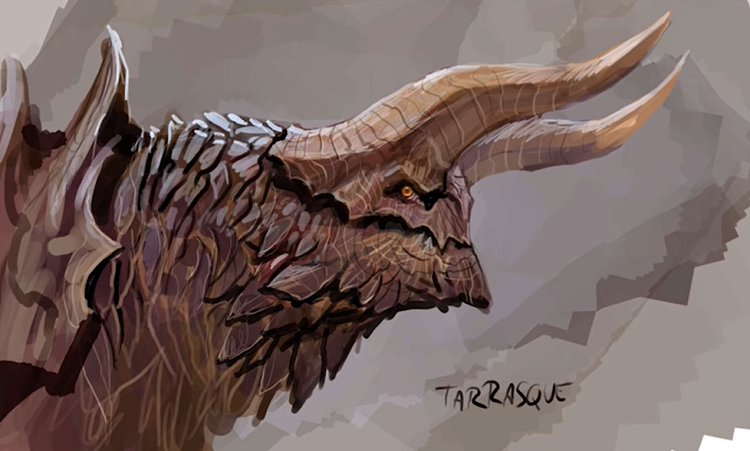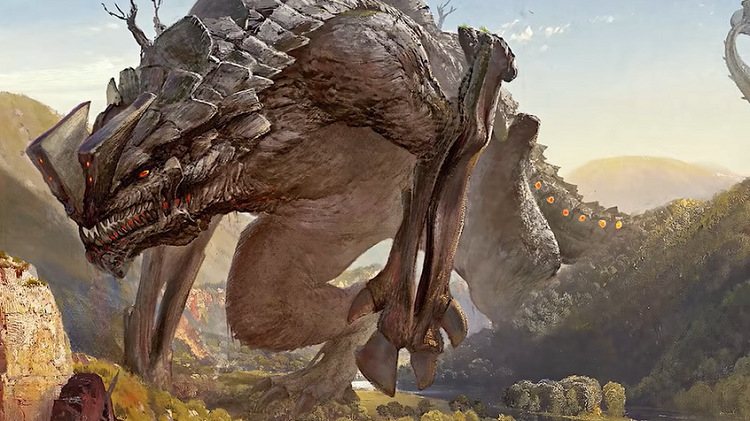In a world filled with creatures carrying secret spells and party wiping abilities, the Tarrasque is pure primal power.
It is the ultimate Kaiju of the Forgotten Realms, and its presence can see the ruin of entire countries. This guide will look into the question, is it worth all that hype?
As of writing this Tarrasque 5e Guide, there are no beasts in Dungeons and Dragons with a higher CR rating than the Tarrasque. The Prince of Demons carries an admirable 26, an ancient red dragon merely 24. The Tarrasque, through mere claw muscle and brawn, has a frightening 30.
Its path of destruction proves you don’t need the magic of the weave, the charisma of the bard, not even an intelligence score to match a flower. All you need is determination, tenacity, and a REALLY big beast.
Even in a land full of Demon Lords, Deities, and Natural Evils, all have come to fear the presence of the primordial Kaiju as one of the few capable of permanently killing them all.
Tarrasque, The Material’s Mightiest Mistake
The Tarrasque is a massive fifty-foot tall and 70-foot long creature that looks like a massively built bipedal dinosaur. It has a back made of thick carapace-like armor that sprouts huge horns and spikes as long as its limbs.
It carries itself like a bird of prey, using its tail for balance while leaning forward much as a raptor or T-rex might. It is capable of swallowing all but the most enormous monsters.
However, it only needs a few bites to take on anything more significant. Should its prey’s power border on the divine, its Three Stomachs will take care of it.
Regardless of divine judgment or extraordinarily bad luck, when the Tarrasque is awake, it knows only its unmatched hunger. Like a predator constantly preparing for its next hibernation, it will leave nothing but destruction between the last spot it napped and the next.
Worse yet, some claim the Tarrasque can never be slaughtered as no plane wants its body or soul. It is said killing it simply sends the Tarrasque into a deep slumber. Chances are, they just never learned to kill a Tarrasque properly.
There is just one, after all. By the mercy of the heavens, let us hope there is only one.
- The Tarrasque can and will eat almost anything considered alive. This includes all plant life.
- The Tarrasque is not quite as intimidating as its CR rating, and lore claims it to be if handled alone.
- The Tarrasque is more effectively used to threaten that town the players love so much or that headquarters they have made into a fortified tank.
- Few forces in the Multiverse of the Forgotten Realms are as destructive as the three stomachs of the Tarrasque.
- The Three Stomachs of the Tarrasque is one of the only ways to permanently kill deity-level entities. This includes Archfey, notoriously unkillable without their Nemesis.
- Even if the Tarrasque doesn’t terrify you, the Three Stomachs are the Nemesis of everything.
- The Tarrasque is immortal because no other plane of existence wants it or its soul. There is no psychopomp across the realms that has gathered the courage to collect its soul.
- The Three Stomachs are even capable of permanently killing an immortal Tarrasque. This is why there is only one.
- The Tarrasque is an accessory to the in-universe reason the spell level maximum is nine.
Stat Block
Tarrasque
Unaligned Gargantuan Monstrosity (titan)
- CR 30 (155,000 XP)
- Passive Perception 10
- AC: 25 (natural armor) Hit Points: 676 (33d20+330)
- Speed 40 ft
- Str 30 (+10) Dex 11 (0) Con 30 (+10)
- Int 3 (-4) Wis 11 (0) Cha 11 (0)
- Saving Throws Int +5, Wis +9, Cha +9,
- Damage Imm.: fire, poison; bludgeoning, piercing, and slashing if nonmagical
- Condition Imm.: charmed, frightened, paralyzed, poisoned
- Senses: Blindsight 120 ft
- Language: NA
- Legendary Resistance (3/day)
Three times per day, upon failing a saving throw, the Tarrasque can choose to automatically succeed without rolling.
- Magic Resistance
Advantage on saving throws against spells and other magical effects.
- Reflective Carapace
The Tarrasque’s carapace is made of magic-resistant diamonds. Ranged spells such as magic missile and Cone of cold do not affect a Tarrasque. A d6 must be rolled to tell if the spell is reflected back to the caster.
-
- On a 1 to 5, the Tarrasque is unaffected.
- On a 6, not only is the Tarrasque unaffected, but the spell is reflected back to the point of origin. Regarding combat, the spell is treated as if the Tarrasque were the caster.
- This includes line and cone spells. If it is ranged and magical, it has a chance to become your problem now.
- Siege Monster
Being an embodiment of gluttonous destruction, the Tarrasque is deals double any damage given to structures, buildings, fortifications, and siege weaponry.
Actions
- Multi-Attack
In a single turn, the Tarrasque can use its Frightful Presence followed by five attacks.
First, it will bite you, then it shreds you with both claws, smacks you with its tail, and for good measure, gouges you with its horns.
If able, it can use Swallow as opposed to Bite.
Frightful Presence, 1 bite, 2 claw, 1 tail, 1 horn.
- Frightful Presence
- Range: Targets must be within 120 feet and aware of the Tarrasque. Effects any targets in range that the Tarrasque chooses.
- Save: DC 17 Wis Save
- Failure: Frightened for 1 minute (10 rounds), immunity for 24hrs after the effect ends.
The target can repeat the save but has disadvantage if the Terrasqure is in view.
If successful or the effect ends, the creature is immune to Frightful Presence for 24 hours.
- Claw
- Roll to Attack: +19
- Range: fifteen feet, single target.
- Hit dmg: 28 (4d8+10) slashing.
- Horn
- Roll to Attack: +19
- Range: ten feet, single target.
- Hit dmg: 32 (4d10+10) piercing.
- Tail
- Roll to Attack: +19
- Range: twenty feet, single target.
- Hit dmg: 24 (4d6+10) bludgeoning.
- Save: DC 20 Str save
- Failure: knocked prone.
- Bite
- Roll to Attack: +19
- Range: ten feet, single target.
- Hit dmg: 36 (4d12+10) piercing.
If the attack hits, the creature is restrained by the Tarrasque’s jaws.
The Tarrasque can only bite-grapple one target at a time.
- Swallow
- Roll to Attack: +19
- Range: ten feet, single target.
- Hit dmg: 36 (4d12+10) piercing.
DMG per turn while swallowed: 56 (16d6) acid damage at the start of the Tarrasque’s turn. Status effects while Swallowed: Blinded, Restrained, total cover from attacks and effects outside the Tarrasque. The inside of a Tarrasque stomach acts as an antimagic barrier.
- While grappling a creature of the large or smaller category, it makes a bite attack, as written above. If this bite attack hits, the creature takes bite damage and is swallowed.
- If a creature inside the Tarrasque causes 60 damage or more, the Tarrasque must succeed in a DC 20 Con Save or regurgitate all swallowed creatures. Regurgitated creatures are left prone on a square within 10 feet of the Tarrasque.
- If the Tarrasque dies, the creature is no longer restrained. They can escape using 30 feet of movement.
Legendary Actions
Legendary actions are actions powerful enemies can take, but only at the end of another creature’s turn.
Only one legendary action can be used at a time.
The Tarrasque can take three legendary actions per round.
- Attack: The tarrasque makes one claw or tail attack.
- Move: The Tarrasque moves up to half its movement speed.
- Chomp (2 Legendary Actions) Bite attack or, if grappling, it may use Swallow instead.
Tarrasque Behavior
The Tarrasque’s only driven to consume. Unfortunately, its diet consists of anyone and anything alive that isn’t the Tarrasque itself. It will devour entire forests as it lumbers its way through and picks cities of their residents while leaving only rubble in its wake.
All but the most powerful or lucky creatures can survive its destruction. However, even they can not survive in its stomach.
While this behavior is terrible for all creatures involved, it is not inherently malicious. The beast is unaligned, after all. This is merely a downside to how large its stomach is.
The path of destruction it leaves behind is made purely from hunger. While some religious sects might put cosmic consciousness behind its awakening, to the Tarrasque itself, it’s just a meal.
Diet
A Tarrasque notably prefers warm blood animals capable of feeding and, thus, further filling themselves with nourishment. However, the Tarrasque will eat and digest anything imaginable.
Of course, it might not get much from the soil or buildings but will still consume them if it believes it will get even a single plant or animal from it. Still, it does know that biting into buildings will often satisfy its hunger through its occasional gooey insides.
That does not mean it won’t feed off of the plants, trees, forest, and fungus with equal delight; it just actively seeks out the Warm-blooded first. It will do this without sleep and take bites of literally anything in its path.
It has no goal, endpoint, or reason to change direction, minus the forward-facing direction it faced after biting down on the last thing it encountered.
The Three Stomachs
The three stomachs of a Tarrasque are considered one of the most powerful forces in the Multiverse of the Forgotten Realms. Suppose the grinding properties of the first stomach doesn’t break you down to a digestible level.
Unfortunately, the outlandish heat of the final stomach will break down even the most indestructible materials. The second can seep nutrition from the item’s very magical essence. It can suck the divine out of a god.
- The Boulder Blender – The first stomach is lined with spines the size of blades as if you turned a pufferfish inside out. Items within this stomach are ground down by the tumbling stones gathered with the Tarrasque’s meals. It is described as hot and wet, with powerful muscles found between the boney blades lining its walls. These are to crush and shatter boulders into tiny bones, open containers, and generally break everything down into smaller, more manageable portions before passing to the second stomach.
- The Corrosive Cauldron – The second stomach is described as an eternally churning pit of corrosive acid. This acid is considered particularly energetic. It is unique in all the planes in its effectiveness. It is so corrosive that it strips the magical essence from everything it breaks down. All but the most powerful items in all the planes are broken down into an acidic slurry. It is even capable of separating a soul from divinity.
- The Spiraling Furnace – The third and final stomach is described as a long, winding tube. Its muscles rhythmically throb like intestines to pull the slurry into a greater and greater heat that boils away the acidic slurry of the previous stomach. The combination of the building acid and the intense heat is so great that nothing in Multiverse has ever survived.
God Disposal
The three stomachs of the Tarrasque are so powerful that they are one of the few items capable of destroying an artifact.
To put this feat into perspective, an artifact is an item so powerful that it is considered to transcend the powers of magic itself. These items are generally wielded by gods, demon princes, and similarly deity-level creatures.
The deity-level creature that wields it is also not safe from the three stomachs of the Tarrasque. The Three Stomachs are one of the few known ways to permanently kill a god while preventing even a new god from being born from their ashes.
An Archfey could permanently be destroyed without requiring their Nemesis. They will never be reborn in the Fey Wylds if they make the full stomach marathon. The three Stomachs are everything’s Nemesis.
This diet is all the Tarrasque is focused on, and it will seek food for weeks, if not months, until it feels satisfied. Only then will it disappear, leaving the territory alone while burrowing off to sleep.
Hibernation Cycle
It is believed by some that the Tarrasque stays dormant for decades or centuries before feeding. This is only true after a hearty feast.
The current average is one day of destruction will give it the energy to allow it to sleep an average of thirty days before needing to awaken and feast. Should it find an average village or town worth of food, that is.
Generally, the Tarrasque will rampage in a territory for about a week before it considers itself full.
It would, on average, take the Tarrasque a month of rampaging to gain a decade or so of peace from it. As such, it is said there are numerous factions dedicated to building up adventurers by killing lesser foes. All to lengthen the period that the Tarrasque will leave them alone.
Adorably, the length of a Tarrasque’s hibernation can grow based on how comfortable it believes its nesting rock is.
The hibernation time can be lengthened through high levels of magic such as wish or miracle. However, the most prolonged period found in the source materials to be recorded is fifty years.
Thankfully, once it has eaten its fill, that area that experienced its destruction will likely never hear from it again. While it is capable and frequently goes on multiple rampages a year, a territory will unlikely see the Tarrasque again for another few millennia.
Furthermore, due to the vast distances between rampages, it is rare for them to even hear news of subsequent rampages.
Earth Glide
The Hibernation chamber of a Tarrasque can not be easily located thanks to its ability to glide cleanly through the Earth. While a hunting Tarrasque will leave a trail of destruction, that destruction will be central to the creations of the living and all the plants and fungus surrounding it.
Once satisfied, the Tarrasque will move deep into the Earth until it can find a massive rock to sleep within. Then, without destroying the stone, it will hibernate inside of it, presumably to keep it from falling to the center of the Earth. As this would be unpleasant, though still not lethal.
The hibernating Tarrasque is described as sharing the space of the solid rock. It does this without disturbing the stone in the slightest. Due to this, discovering where a Tarrasque is hibernated is considered impossible.
Once the Tarrasque disappears to sleep, it will stay in this ‘chamber’ until it reawakens from hunger. It will then glide without leaving any trace of its hibernation or path to its next hunting location.
Instead, it travels so far away that not even reports of its subsequent rampage will ever reach the survivors of its previous rampage. Thanks to how deep it likes to roost, even burrowing straight up, an inch to the left will take it outside the borders of the previous territory.
This is achieved not through digging or moving the Earth or soil but by becoming ‘one’ with the Earth. As there is no mention of its use in its combat block, this ability is only used for hibernation and rest. The Tarrasque has no concept of using it while there is still space in its stomach.
Divine Doctrines
There is said to be only one Tarrasque. However, its presence has still been terrifying enough to become incorporated as a destructive deity of judgment in several different cults and religions.
Their doctrine speaks of this creature in both name and pseudonym, whispering of a beast that slumbers below. These legends claim it is only awakened from its hibernation through a cosmic call like a boogeyman of the divine.
Many religious sects will worship the Tarrasque itself as a higher power. Unsurprisingly, just as many seek reverence in the Three Stomachs.
Thanks to its ability to process everything known to the Multiverse, countless cults and covens have grown to consider the Three Stomachs the true ultimate destroyer, with the Tarrasque merely acting as its vessel.
Hags, in particular, find interest in this sect of Tarrasque devotion. Hag Covens are notorious for relying on the rule of three to milk every ounce of power from reality, down to having a hard limit of three members.
Check out this guide with everything you need to know about Hags in 5e.
Immortality: Lost Potential
While this information is not in the fifth edition monster manual, it was the Tarrasque’s defining feature in 3.5 DnD. The immortality of the Tarrasque made it unkillable by design. Always a danger, constantly sleeping in the depths.
The Tarrasque is ungodly powerful for a feral beast. Still, the unique and cunning strategies devised by armies and colleges alike have proven more devastating and effective than a single Tarrasque. At least, going by the debuff it has received in the fifth edition.
3.5, a Tarrasque held its status as the deadliest monster by being truly unkillable. While this is missing from the stat block, should you genuinely wish to make the Tarrasque a threat to a group of level twenties or above, I suggest adding it back.
If the Tarrasque loses a body part, it will regrow, though, compared to other mythical beasts with this ability, at a much slower rate.
Some limbs might take a few minutes, but their massive limbs could take upwards of an hour. Should the Tarrasque find this too slow, it was capable of reattaching the limb by holding it to the wound.
Should the Tarrasque’s health drop to zero, it will wither away in five minutes. Then, within 1d10 days, it will respawn somewhere deep in the Earth in hibernation. Ready to be woken up once more by hunger or cosmic poking.
The Tarrasque’s regenerative ability was once so great that only using a wish or miracle spell to keep it dead. No form of attack was otherwise capable of dealing lethal damage to it. Not even if disintegrate spell or effect forcing death upon a creature would kill this creature.
The wish can only stop the Tarrasque from regenerating; it can not kill it before you have already done so.
Unfortunately, suppose a heinous individual can get their hand on even a portion of its remains after that. In that case, they could use the wish spell to start its immortal regeneration anew. Otherwise, the best that can be wished for is for the hibernation cycle to be lengthened.
This has been used enough to make the world at large believe the average hibernation cycle of the Tarrasque lasts decades to centuries.
Rewarding the Impossible
The death of a Tarrasque is capable of bringing any who are involved immense fame.
Be it through merely scaring it off, being in the right place just as it began to disappear for hibernation, or actually finding a way to kill the blasted thing, the reputation it will give you will surpass even the gods. At least to those who believe you.
Tangible rewards are scarcer, maybe even impossible. However, legends say that not only will finding a way to indeed kill it gives you the greatest reward. People will actually believe your bar-table boasts! The problem is no one has managed to confirm it.
They say its Carapace is stone with the finest of gems, some of which have never been seen elsewhere in reality.
A single fragment of Tarrasque Carapace can be treated with acid and heated at a continued temperature in a furnace to break down the shell into countless tarrasque diamonds. These are what give the Carapace its reflective quality.
A single Tarrasque Diamond can go for upwards of a thousand gold pieces. Therefore, pursuers of black markets and seedy shops should be mindful that Tarrasque Diamonds are rare, while fakes are plentiful.
The scales of a Tarrasque can be forged into the strongest armor pieces in the world. But unfortunately, doing so will take at least two years for even a master artisan.
The bones themselves are of the highest value to liches and necromancers. Suppose anyone could get their hands on the bones of the unkillable creature. In that case, they could make a catalyst or staff powerful enough to match the three stomachs.
Karsus’s Avatar
The only known 12th LVL spell to ever be cast, Karsus’s Avatar, required a component of the Tarrasque to be cast.
Sources vary, but one required a stone-filled gizzard of a gold dragon into a mixture of Tassasque blood and the bile of a twelve-headed hydra. True or not, it is unanimously considered one of the most metal rituals devised.
Karsus’s avatar was capable of allowing its caster to temporarily steal the power of a god. Replacing themselves in the moment of the spell’s completion with the god of their choosing. The caster, instead, used it to kill the god in question and replace them with himself.
It should be noted that, on average, the highest spell level a player character can cast from is 9th level which usually requires a 17th level or higher mage.
In the universe lore, this spell is why the goddess of magic adjusted the very rules of her domain to prevent any creature from casting a spell higher than level 9.
FAQs
Question: Is the Terrasuqe Worth the Hype?
Answer: Alone and against even a group of level twenty players, the Tarrasque is not worth the hype. If you build this creature up as the lore and specifics do, it will go down surprisingly quickly compared to creatures like the Demogorgon.
Should you wish to make the Tarrasque an interesting encounter, I would suggest using it as a pawn to a more cunning beast, a set-piece summoned by a cult, or a test of power against your party’s tank.
I suggest using its 3.5 immortality rules or using fleeing pedestrians. Include rightened creatures stampeding through the area.
Possibly even a higher intelligence who woke it up in the first place to make themselves more intimidating. To the average creature lore-wise, it lives up to its hype as magical weapons aren’t widespread on a farmer’s salary.
Question: Should I Use the Tarrasque as a One-off fight for Newly Rolled Level 20’s in 5e DnD?
Answer: The danger of the tarrasque is in its lore. Unless testing your skills to make dynamic duos or tanks that can handle a Tarrasque on their own at level 20, it lacks a bit of oomph if you use it purely as a gladiatorial fight for a party of four.
I would personally suggest testing your party out with a gauntlet across the whose who of horror. The Lords of the Nine Hells led by Asmodeus. Maybe even the Demon Princes led by Demogorgon, the Prince of all Demons.
One by one, preferably, taking them on as an actual army of Hell or the Abyss sounds like a nightmare. Easier to spur infighting anyway.
Question: Where did the Tarrasque Come from?
Answer: The answer is not given and the lore all comes shrouded in favor of the varying religions across the Forgotten Realms.
The most conclusive running theory is that a primordial being made it as a means to keep the gods themselves in check, and things got wildly out of hand as the material’s most massive mistake.
Whoever is at fault for this thing will not come forward, so the best the lands of Faerun can decide on is that the creators make mistakes too.
Conclusion
I was initially in the group of DMs and DnD players who immediately sought out the monster in the Monster Manual with the highest record challenge rating.
Unfortunately, like many of these players, I found myself initially disappointed in what the Tarrasque offered.
Sure, it was an absolute monster as a primal powerhouse and to anything lacking magical weapons. However, most parties learned to pack a magical wallop after one too many Black Puddings ate their weapons.
I was terribly wrong in only going off those properties, however, as its lore carries some horrifying potential to a cunning DM.
In actuality, the Tarrasque houses one of the deadliest organs ever created in its three stomachs. Its stat block is lacking in genuinely solidifying just how horrifying its swallow technique is.
It can permanently destroy even the mightiest of entities; not even divine restoration is safe from the Three Stomachs.
Maybe the Tarrasque could even help a group of adventurers finish off that annoying Archfey they owe favors to.
I never said it was a bright idea, just a fun one.
- Blight 5e Guide: Blood-Thirsty Brambles - August 28, 2022
- Constructs 5e Guide: Intimidating Innovation - August 20, 2022
- Modrons 5e Guide - August 13, 2022


